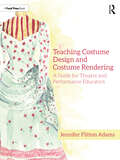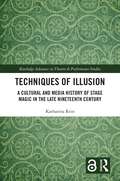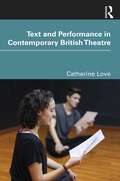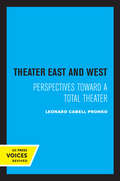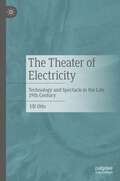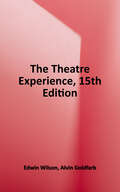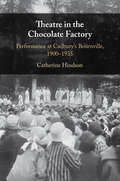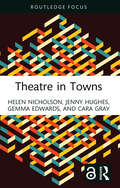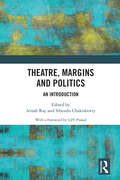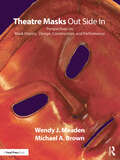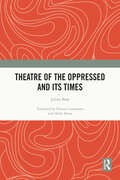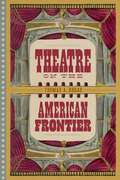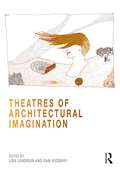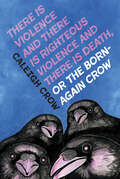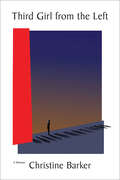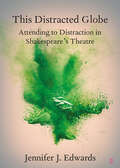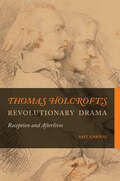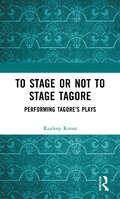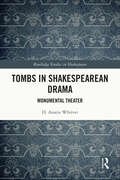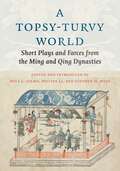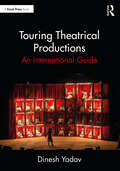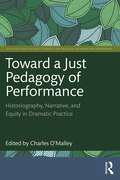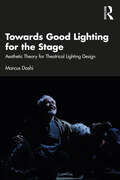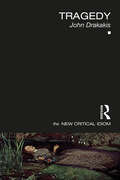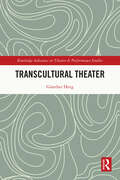- Table View
- List View
Teaching Costume Design and Costume Rendering: A Guide for Theatre and Performance Educators
by Jennifer Flitton AdamsTeaching Costume Design and Costume Rendering: A Guide for Theatre and Performance Educators clarifies the teaching process for Costume Design and Costume Rendering courses and offers a clear and tested path to success in the classroom. Drawing on the knowledge and experience of the author’s twenty-five years of teaching as well as many decades of work by multiple other educators, this book provides a clear roadmap for teaching these two popular Theatre courses. It includes information on pedagogical theory, creating syllabi, preparing and structuring classes, crafting lectures, and analyzing students’ work, with a heavy focus on specific teaching projects that have been proven to work in the classroom. All aspects of teaching costume design and rendering are considered, including body awareness, cultural sensitivities, script analysis, elements and principles of design, psychology of dress, choosing fabrics, period styling, and requirements of dance costumes. Included in the appendices are sample syllabi, and additional reading and research resources. Teaching Costume Design and Costume Rendering is a guide for theatre and performance educators ranging from secondary education to undergraduate programs and graduate studies. It is a valuable resource both for costume educators approaching costume design and rendering classes for the first time and for experienced instructors looking for new material for these courses.
Techniques of Illusion: A Cultural and Media History of Stage Magic in the Late Nineteenth Century (Routledge Advances in Theatre & Performance Studies)
by Katharina ReinThis book explores stage conjuring during its “golden age,” from about 1860 to 1910. This study provides close readings highlighting four paradigmatic illusions of the time that stand in for different kinds of illusions typical of stage magic in the “golden age” and analyses them within their cultural and media-historical context: “Pepper’s Ghost,” the archetypical mirror illusion; “The Vanishing Lady,” staging a teleportation in a time of a dizzying acceleration of transport; “the levitation,” simulating weightlessness with the help of an extended steel machinery; and “The Second Sight,” a mind-reading illusion using up-to-date communication technologies. These close readings are completed by writings focusing on visual media and expanding the scope backwards and forwards in time, roughly to 1800 and to 2000. This exploration will be of great interest to students and scholars in theatre and performance studies.
Text and Performance in Contemporary British Theatre
by Catherine LoveText and Performance in Contemporary British Theatre interrogates the paradoxical nature of theatre texts, which have been understood both as separate literary objects in their own right and as material for performance. Drawing on analysis of contemporary practitioners who are working creatively with text, the book re-examines the relationship between text and performance within the specific context of British theatre. The chapters discuss a wide range of theatre-makers creating work in the UK from the 1990s onwards, from playwrights like Tim Crouch and Jasmine Lee-Jones to companies including Action Hero and RashDash. In doing so, the book addresses issues such as theatrical authorship, artistic intention, and the apparent incompleteness of plays as both written and performed phenomena. Text and Performance in Contemporary British Theatre also explores the implications of changing technologies of page and stage, analysing the impact of recent developments in theatre-making, editing, and publishing on the status of the theatre text. Written for scholars, students, and practitioners alike, Text and Performance in Contemporary British Theatre provides an original perspective on one of the most enduring problems to occupy theatre practice and scholarship.
Theater East and West: Perspectives Toward a Total Theater
by Leonard C. PronkoThis title is part of UC Press's Voices Revived program, which commemorates University of California Press’s mission to seek out and cultivate the brightest minds and give them voice, reach, and impact. Drawing on a backlist dating to 1893, Voices Revived makes high-quality, peer-reviewed scholarship accessible once again using print-on-demand technology. This title was originally published in 1967.
The Theater of Electricity: Technology and Spectacle in the Late 19th Century
by Ulf OttoSince the 1880s, electrical energies started circulating in European theaters, generated from fossil fuels in urban power plants. A mysterious force, which was still traded as romantic life force by some and for others had already come to stand in for progress, entered performance venues. Engineering knowledge, control techniques and supply chains changed fundamentally how theater was made and thought of. The mechanical image machine from Renaissance and Baroque times was transformed into a thermodynamic engine. Modern theater turned out to be electrified theater. – Retracing what happened backstage before the Avantgarde took to the front stage, this book proposes to write the genealogy of theaters modernity as a cultural history of theater technology.
The Theatre Experience
by Edwin Wilson Alvin GoldfarbThe Theatre Experience, 15e prepares students to be well-informed, well-prepared theatre audience members. With an audience-centered narrative that engages today’s students, a vivid photo program that brings concepts to life, and features that teach and encourage a variety of skill sets, students master core concepts and learn to think critically about theatre and the world around them. As a result, students are better prepared for class and better prepared for theatregoing. The textbook is noted for its lively writing style and for helping students recognize how theatre relates to our everyday lives.
Theatre in the Chocolate Factory: Performance at Cadbury's Bournville, 1900–1935
by Catherine HindsonProviding a new way of thinking about industrialism and its history through the lens of one of Britain's most recognisable heritage brands, Catherine Hindson explores the creativity that was at the heart of Cadbury's operation in the early twentieth century. Guided by Quaker Capitalism, employees at Bournville took part in recreational and educational activities, enabling imagination to flourish. Amidst this pattern of work and play arose the vibrant phenomenon that was factory theatre, with performances and productions involving tens of thousands of employees as performers and spectators. Home-grown Bournville casts and audiences were supplemented by performers, civic leaders, playwrights, academics, town planners, and celebrities, interweaving industrialists with the city's theatrical and visual arts as well as national entertainment cultures. This interdisciplinary study uncovers the stories of Bournville's theatre and the employees who made it, considering ground-breaking approaches to mental and physical health and education.
Theatre in Towns
by Helen Nicholson Jenny Hughes Gemma Edwards Cara GrayTheatre in Towns offers a contemporary perspective on the role of theatre in the cultural life of towns in England. Exploring volunteer-led, professional and community theatres, this book investigates the rich and diverse ways that theatres in towns serve their locality, negotiate their civic role, participate in networks of mutual aid and exchange, and connect audiences beyond their geographical borders. With a geographical focus on post-industrial, seaside, commuter and market towns in England, the book opens questions about how theatre shapes the narratives of town life, and how localism, networks and partnerships across and between towns contribute to living sustainably. Each chapter is critically and historically informed, drawing on original research in towns, including visits to performances and many conversations with townspeople, from theatre-makers, performers, set-builders, front-of-house volunteers, to audience members and civic leaders. Theatre in Towns asks urgent questions about how the relationships between towns and theatres can be redefined in new and equitable ways in the future. Theatre in Towns brings new research to scholars and students of theatre studies, cultural geography, cultural and social policy and political sociology. It will also interest artists, policy-makers and researchers wanting to develop their own and others’ understanding of the value of active theatre cultures in towns. The Open Access version of this book, available at www.taylorfrancis.com, has been made available under a Creative Commons Attribution-Non Commercial-No Derivatives 4.0 license.
Theatre, Margins and Politics: An Introduction
by Arnab Ray Sibendu ChakrabortyThis book interrogates the relationship of theatre and the dialectics of centre and the margins. It looks into the exciting world of performance to examine how theatre as an art form is perfectly placed to both perform and critique complex relations of power, politics and culture. The volume looks into how drama has historically served as a stage for expressing and showcasing prevalent social, historical, and cultural contexts from which it has emerged or intends to critique. Including a wide range of performative practices like Dalit theatre, Australian Aboriginal theatre, Western realism and Yoruba theatre, it explores varied lived experiences of people, and voices of subversion, subalternity, resistance and transformation. The book scrutinizes the strategies of representation enunciated through textuality, theatricality and performance in these works and the politics they are inextricably linked with. This book will be of interest and use to scholars, researchers, and students of theatre and performance studies, postcolonial studies, race and inequality studies, gender studies, and culture studies.
Theatre Masks Out Side In: Perspectives on Mask History, Design, Construction, and Performance
by Wendy J. Meaden Michael A. BrownTheatre Masks Out Side In examines masks from different angles and perspectives, combining the history, design, construction, and use of masks into one beautifully illustrated resource. Each chapter includes key information about an element of mask study: history and uses, theatre traditions, practical principles for directing, performing exercises, design considerations, mask-making techniques, and considering makeup as mask. Artist interviews, theatre company profiles, and hundreds of images provide insight into the variety of mask styles and performance applications. Project suggestions, discussion questions, useful worksheets, creative prompts, and resources for sourcing masks are included to inspire further exploration. Theatre Masks Out Side In is designed with the beginning theatre maker in mind, as well as prop makers, costume designers and technicians, and actors learning to use masks in performance.
Theatre of the Oppressed and its Times
by Julian BoalPolitical theatre, like any kind of political action, can only be judged in relation to the political moment in which it tries to intervene. Theatre of the Oppressed (TO) was created to fight against dictatorship and an extremely centralized conception of politics. How does it function now, in a time of social media and so-called participatory democracies? Providing an in-depth account of the political and cultural context in which TO emerged, this book asks: How do contemporary understandings of concepts like oppression, representation, participation, and emancipation shape TO today? Highlighting the pitfalls of reducing oppression to one-to-one relationships, the book proposes a version of Forum Theatre dramaturgy that portrays oppression as a defining structure of societies. The author also shares specific examples of movements and other organizations that use Theatre of the Oppressed to construct themselves. Theatre of the Oppressed and Its Times is an essential text for practitioners and scholars of TO, applied theatre practitioners, students, and anyone interested in how theatre can concretely assist in the transformation of the world.
Theatre on the American Frontier
by Thomas A. BogarFor two centuries, nearly all historical accounts of American theatre have focused on New York, Boston, and Philadelphia. As a result, the story of theatre on the frontier consists primarily of regional studies with limited scope. Thomas A. Bogar’s Theatre on the American Frontier provides an overdue, balanced treatment of the accomplishments of the troupes working in the trans-Appalachian West.From its origins in late eighteenth-century Pittsburgh, New Orleans, and Louisville, frontier theatre grew by the close of the nineteenth century to encompass more than a dozen centers of vibrant theatrical activity. Audiences—mainly pioneers struggling with the hardships of establishing a life in the backcountry—enjoyed thrilling melodramas, the comedies of George Colman the Younger and John O’Keeffe, and even the tragedies of William Shakespeare. Theatre companies that ventured into this challenging and unfamiliar territory did so with a combination of daring and determination. Bogar’s comprehensive study brings this neglected history into the spotlight, cementing these figures and their theatrical productions and practices in their rightful place.
Theatres of Architectural Imagination
by Lisa LandrumThis volume explores connections between architecture and theatre, and encourages imagination in the design of buildings and social spaces. Imagination is arguably the architect’s most crucial capacity, underpinning memory, invention, and compassion. No simple power of the mind, architectural imagination is deeply embodied, social, and situational. Its performative potential and holistic scope may be best understood through the model of theatre. Theatres of Architectural Imagination examines the fertile relationship between theatre and architecture with essays, interviews and entr’actes arranged in three sections: Bodies, Settings, and (Inter)Actions. Contributions explore a global spectrum of examples and contexts, from ancient Rome and Renaissance Italy to modern Europe, North America, India, Iran, and Japan. Topics include the central role of the human body in design; the city as a place of political drama, protest, and phenomenal play; and world-making through language, gesture, and myth. Chapters also consider sacred and magical functions of theatre in Balinese and Persian settings; eccentric experiments at the Bauhaus and 1970 Osaka World Expo; and ecological action and collective healing amid contemporary climate chaos. Inspired by architect and educator Marco Frascari, the book performs as a Janus-like memory theatre, recalling and projecting the architect’s perennial task of reimagining a more meaningful world. This collection will delight and provoke thinkers and makers in theatrical arts and built environment disciplines, especially architecture, landscape, and urban design.
There is Violence and There is Righteous Violence and There is Death or, The Born-Again Crow
by Caleigh CrowGrocery-store clerk Beth has had a hell of a week. A hell of a life, actually, full of people squashing her soul. And after pushing back at life—stabbing a steak to her boss’s desk and lighting a magazine rack on fire, for instance—freshly unemployed Beth regroups at her mom’s suburban home. Just when Beth starts to think she’s to blame for systemic limits, the gift of a bird feeder sparks a relationship with a talking Crow who reconnects her with her true power.This sly chamber piece from new voice Caleigh Crow turns post-capitalism ennui on its head with a righteous fury. It unearths the subtle (and not so subtle) ways we gaslight the marginalized, especially Indigenous women, people living with mental-health afflictions, and anyone struggling to make ends meet in low-income service jobs. There Is Violence captures the vivacity and humour of one truly remarkable woman not meant for this earth, and brings her to her own glorious transcendence.
Third Girl from the Left
by Christine Barker&“A beautifully written memoir of life on the Broadway stage at the onset of the 1980s AIDS epidemic . . . Compelling, and remarkably hopeful.&” —Mara Liasson, National Political Correspondent, NPR A moving, real-life account of making it as a dancer in New York City, embracing the changing faces of love and family, and being at ground-zero for one of the most fatal epidemics of modern times . . . Wanting to be a dancer while growing up in a large military family made Christine Barker somewhat of a black sheep, but she followed her dreams to New York City, where—in a moment of almost unbelievable good fortune—she was chosen for the London cast of A Chorus Line. London, and then New York, in the seventies and eighties opened up Christine&’s world. The creativity, culture, and nightlife were intoxicating, enough so to compel her older brother Laughlin to join her. Once there, the divorced father, veteran, and corporate lawyer met rising fashion star Perry Ellis. Romance and success soon followed—as well as rumors of a devastating new disease . . . Broadway&’s theater community is ravaged by loss as the AIDS epidemic takes hold, and Christine is shocked by the toll it&’s taken on her inner circle. Holding on tight to friends and loved ones left behind, the crisis becomes a crucible moment for her family and for all of society. And Christine is once again forced to go her own way to make sense of the tragedy.
This Distracted Globe: Attending to Distraction in Shakespeare's Theatre (Elements in Shakespeare Performance)
by Jennifer J. EdwardsThis Element attends to attention drawn away. That the Globe is a 'distracted' space is a sentiment common to both Hamlet's original audience and attendees at the reconstructed theatre on London's Bankside. But what role does distraction play in this modern performance space? What do attitudes to 'distraction' reveal about how this theatre space asks and invites us to pay attention? Drawing on scholarly research, artist experience, and audience behaviour, This Distracted Globe considers the disruptive, affective, phenomenological, and generative potential of distraction in contemporary performance at the Globe.
Thomas Holcroft’s Revolutionary Drama: Reception and Afterlives (Transits: Literature, Thought & Culture, 1650-1850)
by Amy GarnaiA key figure in British literary circles following the French Revolution, novelist and playwright Thomas Holcroft promoted ideas of reform and equality informed by the philosophy of his close friend William Godwin. Arrested for treason in 1794 and released without trial, Holcroft was notorious in his own time, but today appears mainly as a supporting character in studies of 1790s literary activism. Thomas Holcroft’s Revolutionary Drama authoritatively reintroduces and reestablishes this central figure of the revolutionary decade by examining his life, plays, memoirs, and personal correspondence. In engaging with theatrical censorship, apostacy, and the response of audiences and critics to radical drama, this thoughtful study also demonstrates how theater functions in times of political repression. Despite his struggles, Holcroft also had major successes: this book examines his surprisingly robust afterlife, as his plays, especially The Road to Ruin, were repeatedly revived worldwide in the nineteenth century.
To Stage or Not to Stage Tagore: Performing Tagore's Plays
by Rajdeep KonarRabindranath Tagore (1861‒1941) was a prolific playwright with more than thirty plays to his credit. He is also known for his life-long, passionate engagement with theatre, first at Jorasanko and then at Santiniketan, in multiple roles as actor, director, singer, musician. However, during his own life-time and even after his demise, his experimental plays have proved challenging for directors to stage. Time and again they have been written off as unstageable by prominent theatre makers. Further complications have arisen from the presence of a spectre of authority around Tagore and his plays often promoted by Visva-Bharati, the institution he founded and which held the copyright of his works till 2001. This book travels through time and space intending to untangle the enigma presented by Tagore’s plays. The book on one hand immerses itself into the archive of Tagore’s plays and his dramaturgy of them in order to problematize the ways in which they have been interpreted. On the other, it also engages with productions of Tagore’s plays during and after his life-time to understand the challenges directors have faced while staging them and the strategies they have embraced to circumvent them. While performing a subjective critical reading of the Tagore theatre-archive, an underlying objective of the book remains to understand the very concept of the archive, as it manifests itself in contemporary dramatic theatre.
Tombs in Shakespearean Drama: Monumental Theater (Routledge Studies in Shakespeare)
by H. Austin WhitverTombs in Shakespearean Drama explores the rhetorical deployment of tombs and monuments on the early modern stage, demonstrating their historiographic power and mythmaking potential. By analyzing references to tombs in plays by Shakespeare and others in conjunction with extant monuments, this volume demonstrates how these references function in two overlapping ways in period drama: monuments act as repositories of information about the past, and they allow the living to construct and preserve fictive narratives. The stage exposes the flimsy materiality of paper, placing less value on the written word than period poetry. In this way, critics have perhaps oversold as universal Shakespeare’s poetic praise of stone. Tombs within plays act as a powerful historical and narrative medium, raising the stakes to provide the stage with the illusion of permanency. Playwrights use tombs to anchor the stage action, giving a sense of lasting importance to dramatic events and combatting the ephemeral nature of the playhouse. In drama, Shakespeare and others drew on the persona preserved on tombs; this volume widens our view of how these representations interacted in the commemorative economy of early modern England. Within the playhouse, it was the tomb, not the tome, that stood as a symbol of permanence.
A Topsy-Turvy World: Short Plays and Farces from the Ming and Qing Dynasties (Translations from the Asian Classics)
by Wilt L. Idema, Wai-Yee Li, and Stephen H. WestPlaywriting in many forms flourished during the late Ming and early Qing dynasties. Shorter theatrical genres in particular offered playwrights opportunities for experimentation with both dramatic form and social critique. Despite their originality and wit, these short plays have been overshadowed by the lengthy masterpieces of the southern drama tradition.A Topsy-Turvy World presents English translations of shorter sixteenth-to-eighteenth-century plays, spotlighting a lesser-known side of Chinese drama. Satirical and often earthy, these mostly one-act plays depict deceit, dissembling, reversed gender roles, and sudden upending of fortunes. With zest and humor, they portray henpecked husbands, supercilious and lustful monks, all-too-human sage kings, disgruntled officials, and overreaching young scholars. These plays provide a glimpse of Chinese daily life and mores even as they question or subvert the boundaries of social, moral, and political order.Each translation is preceded by a short introduction that describes the play’s author, context, formal qualities, and textual history. A Topsy-Turvy World offers a new view of a significant period in the development of the Chinese theatrical tradition and provides insight into the role of drama as cultural critique.
Touring Theatrical Productions: An International Guide
by Dinesh YadavTouring Theatrical Productions: An International Guide is a practical and comprehensive overview of planning, staging and closing international touring productions. This book offers a step-by-step chronological journal of preparing a company for international touring, from applying for international visas to returning home after a tour. It includes discussions of invitations, contracts, scheduling, health and safety, personnel, packing and shipping, certifications, insurance, travel, unions, hotels, ethics and cuisines. Each chapter is filled with guidelines, samples of paperwork and checklists to ensure the smooth running of any international tour. Written by the Production Manager and Technical Director of India’s most travelled show The Manganiyar Seduction with Can & Abel Theatres, this book includes examples, incidents and experiences of performing in over 20 countries with over 200 shows. This how-to guide will benefit Technical Directors and Production Managers of touring productions, as well as students in Production Management, Tour Management, Art Administration and Technical Theater courses.
Toward A Just Pedagogy Of Performance: Historiography, Narrative, And Equity In Dramatic Practice (Routledge Series in Equity, Diversity, and Inclusion in Theatre and Performance)
by Charles O’MalleyThis book is a compendium of resources largely by and for artists and scholars interested in engaging in conversations of justice, diversity, and historiography in the fields of theatre and performance studies. For these students, and for the future instructors in our field who will use this book, we hold a tripartite hope: to expand, to enable, and to provide access. In its whole, we intend for this book to provoke its readers to question the narratives of history that they’ve received (and that they may promulgate) in their artistic and scholarly work. We aim to question methods and ethics of reading present in the western mode of studying drama and performance history. The contributions in the book—not traditional chapters, but manifestos, experiences, articles, conversations, and provocations—raise questions and illuminate gaps, and they do not speak in a unified voice or from a static position. These pieces are written by artists, graduate students, teachers, administrators, and undergraduates; these are expressions of hope and of experience, and not of dogma. This book is aimed toward instructors of undergraduates, both graduate students and faculty at all levels of seniority within theatre and performance studies, as well as at artists and practitioners of the art that wish to find more just ways of viewing history.
Towards Good Lighting for the Stage: Aesthetic Theory for Theatrical Lighting Design
by Marcus DoshiTowards Good Lighting for the Stage: Aesthetic Theory for Theatrical Lighting Design explores the theoretical underpinnings of effective lighting design from conceptualization to live performance. Through an investigation of the author’s own aesthetic point of view—grounded in a broad investigation of art and design that blends pop culture and fine art, theory, and practice—this book documents the author’s thinking on the design process to fill the unexplored gap between an aesthetic philosophy and its expression in composition. Redefinitions of the artist, artwork, and spectator link beauty and artistic efficacy to arrive at a set of principles for assessment that demand that contemporary lighting design surpass utilitarian visibility to become a vital part of the total artwork that is a theatrical production. Inspired by the movements of the broader art and design worlds of the mid-19th century through present day—citing influences as diverse as Jennifer Tipton, Lois Tyson, Dieter Rams, and Dave Hickey—this book charts a course from the artistic team’s dramaturgical work to a solo studio concept to the tech table. Engaging and wide-ranging, Towards Good Lighting for the Stage synthesizes years of cross-disciplinary research and case studies of the author’s own work into provocative reading for practitioners of lighting design, advanced students, and academics, as well as those interested in connecting theatrical practice, aesthetic theory, and visual art.
Tragedy (The New Critical Idiom)
by John DrakakisTragedy is one of the oldest and most resilient forms of narrative. Considering texts from ancient Greece to the present day, this comprehensive introduction shows how tragedy has been re-imagined and redefined throughout Western cultural history. Tragedy offers a concise history of tragedy tracing its evolution through key plays, prose, poetry and philosophical dimensions. John Drakakis examines a wealth of popular plays, including works from the ancient Greeks, Shakespeare, Bertolt Brecht, Sarah Kane and Tom Stoppard. He also considers the rewriting and appropriating of ancient drama though a wide range of authors, such as Chaucer, George Eliot, Ted Hughes and Colm Tóibín. Drakakis also demystifies complex philosophical interpretations of tragedy, including those of Hegel, Kierkegaard, Nietzsche and Benjamin. This accessible resource is an invaluable guide for anyone studying tragedy in literature or theatre studies.
Transcultural Theater (Routledge Advances in Theatre & Performance Studies)
by Günther HeegTranscultural Theater outlines the idea of a transcultural theater as enabling an approximation to and an interaction with the foreign and the alien. In consideration of the allure of fundamentalist and populist movements that promote the development and practices of xenophobia worldwide, this book makes a powerful plea for the art of theater as a medium of conviviality with (the) foreign(er) that should not be underestimated. This study contributes to transcultural experience, artistic practice, and education in the medium of theater. The book’s investigation extends far into space and time and pays particular attention to the relationship between aesthetic experience, artistic practice, and academic representation. This book is for scholars and students as well as for all those working in the cultural field, especially in the field of cultural transfer.
